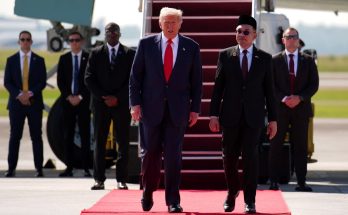
It’s an unfolding narrative of opportunity and optimism as India and the 10–nation ASEAN prepare to celebrate 25 years of dialogue partnership in 2017. A historic milestone for New Delhi’s reinvigorated Act East policy, the commemorative summit will mark 15 years of the summit-level interaction and five years of strategic partnership between India and ASEAN, home to over 1.8 billion people and dynamic growth hubs in the evolving geo-economic landscape of the region. “Shared Values, Common Destiny” – the summit’s theme encapsulates the essence of India’s blossoming relations with the Association of Southeast Asian Nations. It is animated by a soaring vision of an Asian century and a commitment to shaping an inclusive regional order.

Announcing the silver jubilee celebrations at the 14th ASEAN-India summit in the Laotian capital, Vientiane, on September 8, Prime Minister Narendra Modi spoke eloquently about the promise and potential of this crucial partnership. “The planned commemorative activities are ambitious, just as the promise and potential of our strategic engagement is immense. In India, you would find a ready and reliable partner, willing to march with you in step to fulfil this promise and realise its potential,” PM Modi told the ASEAN leaders.
The year-long celebrations, to be launched at an ASEAN-India Foreign Ministers’ Meeting in 2017, will encompass a diverse array of activities that will illuminate myriad facets of the ASEAN-India relationship. The calendar of celebratory events will include, among others, a business summit, CEOs Forum, a car rally and sailing expedition, and cultural festivals.
From Look East to Act East

In many ways, this 25–year journey of marching together with a shared vision has been uniquely empowering and exhilarating for both India and ASEAN, which have come to forge an all-encompassing partnership straddling just about every area of human endeavour. The launch of the dialogue partnership between India and ASEAN flowed from the visionary initiative taken by India’s then Prime Minister PV Narasimha Rao to launch the Look East policy in 1991. It coincided with economic reforms and India embracing globalisation. The Look East policy was driven by the idea of blending the potential of India and its emerging strengths with technology, innovation and capital in ASEAN countries. In the succeeding years, the partnership witnessed the initiation of summit-level meetings in 2002, the elevation of relations to the level of strategic partnership in 2012, the signing of the ASEAN-India FTA in Goods in 2009 and the FTA in services and investment in 2014.
Since PM Modi took charge of the world’s largest democracy, the Look East policy has acquired an added traction and salience in India’s foreign policy calculus and transformed into Act East policy that underscored greater political commitment to upgrading India’s relations with ASEAN and its extended eastern neighbourhood. This economically vibrant region is increasingly getting linked up with India’s development agenda, pivoted around interlinked programmes of ‘Make in India’, ‘Digital India’, ‘Smart Cities’, ‘Start-up India’, ‘M-Governance’ and ‘Skill India’.

Economic win-win
The two sides are stepping up their efforts to upscale their bilateral trade to $200 billion by 2022. At the summit in Vientiane, the two sides focussed on fast-tracking implementation of the ASEAN-India Trade in Services and Investment Agreements and completion of the ongoing review of ASEAN India Trade in Goods Agreement at the earliest. India proposed development of an ASEAN-India network of Business Chambers and Thailand agreed to host the ASEAN-India Business Fair in 2017 to leverage new opportunities arising from FTA. The signing of a Free Trade Area in goods in 2009 has been followed by the sealing of ASEAN-India Agreements on Trade in Services and Investment in November 2014, which entered into force on July 1, 2015. The setting up of ASEAN-India Centre for Investment is expected to lead to enhanced two-way investment.
Strategic depth

India and ASEAN are also looking to imbue their bilateral ties with greater strategic depth through enhanced consultation on cross-cutting issues like terrorism, piracy and climate change. “Our engagement with ASEAN is not just about a solid base of shared civilisational heritage. It is also driven by our common strategic priorities of securing our societies and bringing peace, stability and prosperity to the region. ASEAN is central to India’s ‘Act East’ policy. And, our ties are a source of balance and harmony in the region,” said PM Modi at the summit in Vientiane.
The continuing volatility in the South China Sea has imparted an added urgency to enhancing security cooperation across the spectrum, with special focus on maritime security and freedom of navigation. ASEAN remains pivotal to addressing the traditional and non-traditional security challenges facing the Asia Pacific region. Securing the seas, as PM Modi said, is a shared responsibility. “India supports freedom of navigation, over-flight and unimpeded commerce, based on the principles of international law, as reflected in the United Nations Convention on the Law of the Sea. And, we are ready to play our part in partnership with ASEAN.”
Enhanced connectivity
Enhancing connectivity, physical, digital, economic, institutional and cultural, is a primary driver of ASEAN-India relations. India has robustly backed fast-tracking a host of connectivity projects that will quicken regional integration and has supported the Master Plan on ASEAN-Plus Connectivity (MPAC). Recently, India announced the setting up of a joint task force on connectivity to carry forward the exploratory work on the extension of India-Myanmar-Thailand Trilateral Highway to Cambodia, Laos and Vietnam. Enhancing connectivity to Southeast Asia is critical to unlocking the economic energies and enterprise of India’s north-eastern states.
Development partnership
The enhancement of the ASEAN-India Science and Technology Development Fund from $1 million to $5 million and setting up of an ASEAN-India Inclusive Innovation Platform to facilitate commercialisation of low cost technologies are important steps in deepening development partnership. Building on its core strengths in knowledge partnership, India is assisting in capacity building in less developed ASEAN countries through setting up institutions like the Entrepreneurship Development Centres (EDCs), Centres of Excellence in Software Development and Training, and Centers for English Language and Training (CELTs) in CLMV (Cambodia, Myanmar, Lao PDR and Vietnam) countries.
The Long View: Co-scripting Asian century
With the Act East policy moving onto fast-track, India has re-articulated the centrality of ASEAN in its expanding relations with the extended East Asian region. India has vigorously supported major ASEAN-centric initiatives – the creation of an ASEAN Community by 2015, the ASEAN Community Vision 2025, the Initiative for ASEAN Integration (IAI), the Narrowing of the Development Gap, and the Master Plan on ASEAN Connectivity 2025. The blueprint for accelerating ASEAN-India cooperation is enshrined in the ASEAN-India plan of action for the period 2016 to 2020, entitled “Partnership for Peace, Progress and Shared Prosperity.” The progress has been rapid, with priority years drawn up and 54 out of the 130 jointly already implemented. Backing its commitment to the region with funds, PM Modi announced a Line of Credit of US$ 1 billion at the 13th ASEAN-India summit in Kuala Lumpur to promote projects that support physical and digital connectivity. At the Vientiane summit, India announced enhancing the ASEAN-India Fund with an additional US$ 50 million.
 Beyond geopolitics and geo-economics, the cultural and spiritual connections impart a special flavour to ASEAN-India relations. Buddhism remains an enduring bond, which is being revitalised with the revival of NalandaUniversity into an international knowledge hub. ASEAN leaders are all praise for India’s proposal to document civilisational ties by mapping Indian inscriptions along the Mekong river as well as documentation of shared cultural symbols. The ASEAN Studies Centre in Shillong promises to expand cross-border ties of trade, tourism and cultural exchanges.
Beyond geopolitics and geo-economics, the cultural and spiritual connections impart a special flavour to ASEAN-India relations. Buddhism remains an enduring bond, which is being revitalised with the revival of NalandaUniversity into an international knowledge hub. ASEAN leaders are all praise for India’s proposal to document civilisational ties by mapping Indian inscriptions along the Mekong river as well as documentation of shared cultural symbols. The ASEAN Studies Centre in Shillong promises to expand cross-border ties of trade, tourism and cultural exchanges.
Building on a quarter century of all-round expansion of relations, India and ASEAN are now looking to explore new frontiers and climb new peaks as they celebrate the silver jubilee of their dialogue partnership. As they look ahead to the next few decades of mutually empowering engagement, India and ASEAN must aim big, walk the talk and think strategically to fructify the dream of an Asian century. Positioning people at the heart of their blossoming relationship and shaping a balanced regional order amid shifts in the world order will be central to their shared journey.
— This article was first published in the November-December edition of India Perspectives.
Author Profile

- Manish Chand is Founder and Editor-in-Chief of India Writes Network (www.indiawrites.org) and India and World, a pioneering magazine focused on international affairs. He is CEO, Centre for Global India Insights, an India-based think tank focused on global affairs.
Latest entries
 India and the WorldOctober 27, 2025Modi hails the century of India and ASEAN, backs ASEAN centrality
India and the WorldOctober 27, 2025Modi hails the century of India and ASEAN, backs ASEAN centrality India and the WorldOctober 26, 2025Act East: Five reasons why ASEAN summit in Malaysia matters
India and the WorldOctober 26, 2025Act East: Five reasons why ASEAN summit in Malaysia matters India and the WorldOctober 25, 2025Malaysia Summit: India can play a bigger role in ASEAN: Anil Wadhwa
India and the WorldOctober 25, 2025Malaysia Summit: India can play a bigger role in ASEAN: Anil Wadhwa India and the WorldOctober 2, 2025With US frowning, India to host Putin in December
India and the WorldOctober 2, 2025With US frowning, India to host Putin in December







